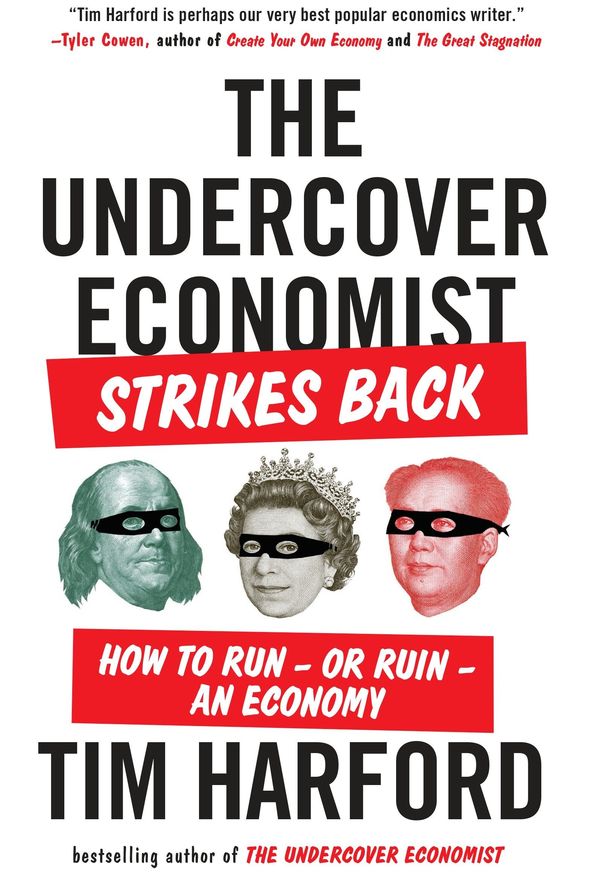
The Undercover Economist Strikes Back
How to Run - or Ruin - an Economy
کتاب های مرتبط
- اطلاعات
- نقد و بررسی
- دیدگاه کاربران
نقد و بررسی

November 11, 2013
In his follow-up to The Undercover Economist, Financial Times columnist Harford brings vigor and even humor to otherwise dry topics such as the difference between GDP and GDP per capita. Presented as a Socratic dialogue between Harford and the reader, with questions that can veer cutesy and answers that become arch, the reader is treated nonetheless to a thorough happily concise explanation of economic policies and issues. After discussing microeconomics and the Keynesian approach, which Harford openly supports, the last third of the book focuses on macroeconomics, an analysis that takes into account more outside influences. By Harford’s own admission, the complex nature of culture and populations makes the outcome of any economic policy virtually impossible to forecast, which makes the book’s title disappointingly inaccurate. The economist not only doesn’t strike back, he doesn’t strike at all. By presenting explanations of, but no opinions on, the efficacy of economic responses, Harford leaves it to readers to form their own conclusions as to why the microeconomic stimulus plan in the U.S. was neither more nor less effective than the more macroeconomic austerity measures in Europe. However, by remaining noncommittal and demystifying the topic, Harford brings clarity to what has often been comprehensible to only a select few. Agent: Zoe Pagnamenta, Zoe Pagnamenta Agency.

December 1, 2013
It's hard enough to manage, or even understand, our own finances. The "Undercover Economist" seeks to teach us how to manage the economic affairs of nations. Before we can fix the world's dysfunctional economies, Financial Times columnist Harford (Adapt: Why Success Always Starts with Failure, 2011, etc.) would have us understand the forces that make national and global fortunes thrive or fail--i.e., macroeconomics. Harford is a Socratic sort of tutor; here, he presents the questions from the point of view of a wonkish student. Money, we learn, encompasses three things: a store of value, a medium of exchange and a means of accounting. Harford neatly defines such terms as "nominal GDP targeting," "recession," "liquidity trap," "price rigidity," "consumption smoothing" and "spending multiplier." Remarkably, it is all quite accessible and occasionally waggish. Readers will easily follow a discussion of stimulus versus austerity and determining the right amount of inflation (3 or 4 percent). The author also notes that printing money is sometimes a good practice. John Maynard Keynes, the patriarch of modern macroeconomics, is the right fellow for the short term, and the classic economists are fine for the long haul. As the recent crisis teaches, understanding and managing a global economy is difficult and complex, requiring many thinkers. Harford examines Keynes, Paul Samuelson, Paul Krugman, Joseph Stiglitz and other wise practitioners. There is much to learn from the Underground Economist's primer, though against whom he is striking back, as the title has it, isn't clear. Readers may not be called upon to manipulate the world's economies, but the next time a conversation turns to the "Phillips Curve," Harford's students need not be excluded. Uncovering cant and weak practice with some common sense and plenty of experience, Harford puts the art of macroeconomics within reach, making the unruly study considerably less dismal.
COPYRIGHT(2013) Kirkus Reviews, ALL RIGHTS RESERVED.

February 1, 2014
Per Economics Affairs book reviewers, the world was eager nearly a decade ago for commonsense explanations of microeconomics including Harford's previous work, The Undercover Economist, which offered a clear picture of who gets what and why. Now the Financial Times columnist, author, and occasional BBC host turns to macroeconomics, aiming to answer the question: Why is it so difficult to run an economy? The author sees the takeaway as the knowledge that not all recessions are alike and that economists are arguing about what kind of recession we are experiencing now. His chatty style, sprinkled with slang (e.g., "big glugs of spending power"), may put off a few readers, and some will not appreciate Harford's conceit of a dialog asking readers to think through various economic arguments rather than accepting pat answers to global economic problems. VERDICT Independent thinkers aspiring to a better understanding of the world economy and of possible fixes for the current downturn will delight in this crisp, readable, and knowledgeable explication and analysis of macroeconomic events and theoretical perspectives.--Elizabeth Wood, Bowling Green State Univ. Libs., OH
Copyright 2014 Library Journal, LLC Used with permission.

August 1, 2013
Having taught us the basics in his best-selling The Underground Economist, Financial Times columnist Harford here gives us instruction in macroeconomics, e.g., the study of how the global economy works, starting with a user-friendly question: What would you do if you ran the world's economy? He also explains why we should care.
Copyright 2013 Library Journal, LLC Used with permission.

























دیدگاه کاربران